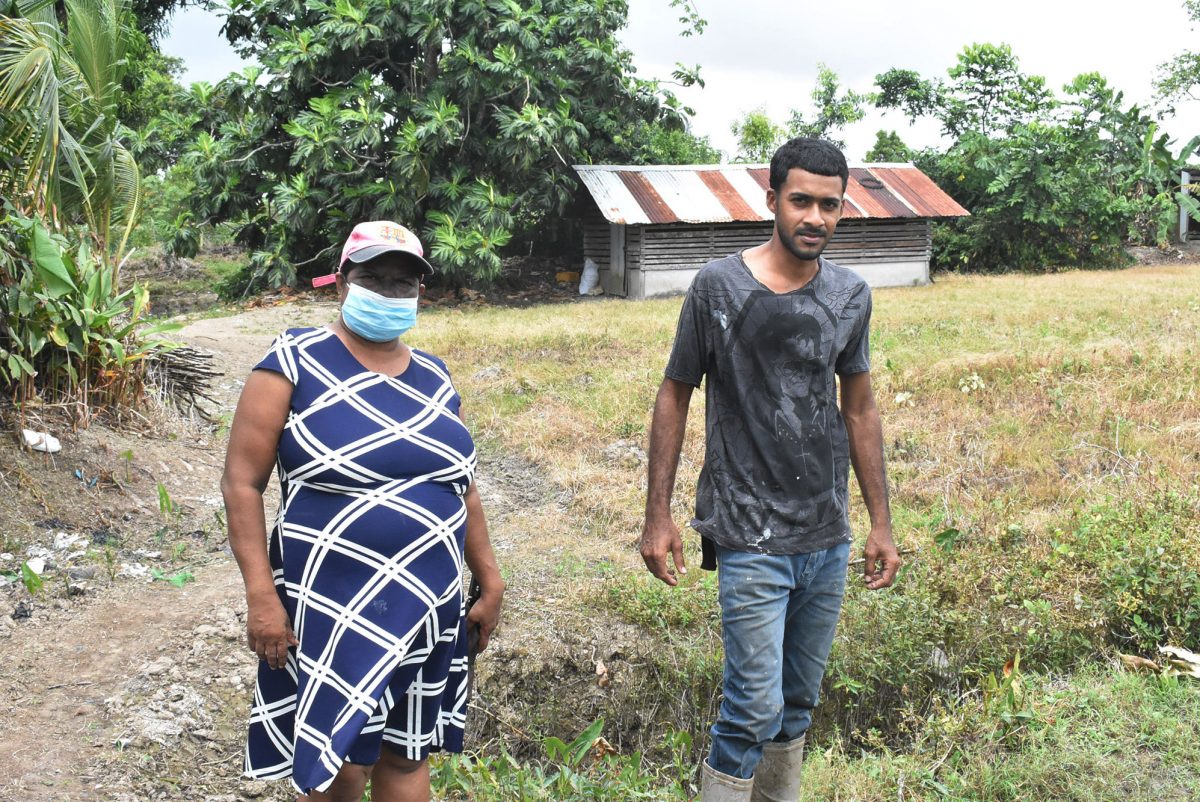At 54, Patricia Persaud appears to reflect on her life with a considerable measure of satisfaction. She used to be the ‘other half’ in a union of two teachers-turned-farmers and part of the community of Parika Back farmers whose pursuits have been filled with both challenges and rewards.
Patricia grew up on the farming island of Wakenaam then ‘migrated’ to Parika Back after leaving secondary school in the mid-1980’s.
Pushed in the direction of farming by the availability of abundant farm land, she took an interest. Perhaps not altogether surprisingly, she married a farmer one year after moving to Parika Back. Herself from a farming family she took to her new life like a duck to water. She felt too that working in the fields side by side with her husband was the best form of support that a wife could give. Teachers’ salaries being a ‘country mile’ away from being a king’s ransom, farming also represented a not insignificant family subsidy. The two grew potatoes and cassava on a plot of land close to her mother-in-law’s residence and sold the produce to middlemen.
Fifteen years ago, the couple along with their two sons, moved to their own home at Naamryck, Parika Back. They also switched to cash crop cultivation. The adjustment was due, primarily, to the advantage of an improved crop cycle associated with the cultivation of cash crops. That, along with their newly acquired house lot and the acquisition of tilling machinery, better positioned them to become independent farmers.
These days, one of the couple’s sons, Raul, is a farmer in his own right. He cultivates peppers, cabbage, pak choi, okra, and tomatoes.
Navigating her way through teaching whilst working simultaneously as a farmer, has been, Patricia says, challenging, though she quickly adds that the best results come from resilience and adaptability. She recalls instances in which investments in crops failed to yield anticipated returns. “What do you do? You continue to plant, hoping for a better return the next season,” she says. She recalls, as well, “instances when the bounty was good.”
Like most of the farmers at Parika Back, Patricia sells her produce to the middlemen who visit the village daily. It appears that her profession as a teacher has also served her negotiating skills well.
Time, in the circumstance of her double role as a teacher and farmer, is of the essence. Her days start at around 5:00 am with the preparation of the first meal of the day – breakfast. At around 6:30, she heads to the farm which, thankfully, is adjacent to the family home. She returns home around 8:00 am to prepare for school. A full day in front of a class is followed by a two-hour return to the farm, commencing at around 5:00 pm.
Weekends and holidays offer little respite. Those, too, are working days. Amidst all this she must find time to mark students’ homework, prepare lessons plans and teaching aids, and, in some instances, perform other in-school supervisory duties.
Reliable water supply is the bane of Parika Back’s farming existence. There are days, Patricia says, when the canal is dry. On those days the farmers must resort to the conservancy canal which, she says has become a constant source of differences between the cash crop farmers and the cattle farmers. The controversy centres on the timing of the release of water from the conservancy. Patricia supports a system of pumps that can be used to transport water from the canals to the farms.
The family has invested in a drip irrigation mechanism. It affords a watering technique that focuses on providing adequate water for the more vulnerable crops. While the initial investment can be exacting, the longer-term payback compensates, Patricia says.
The Food and Agriculture Organization (FAO) and the Inter-American Institute for Cooperation on Agriculture (IICA) have launched a climate-smart agriculture pilot project for farmers in Parika Back and Naamryck as a response to the water challenge. Last April Patricia was one of the farmers selected to participate in training associated with the project. The exercise featured the cultivation of ‘delicate’ crops including lettuce, celery and broccoli inside shade houses. Access to the knowledge meant that the destruction of crops during periods of heavy rainfall has been minimised, Plant diseases have also been significantly reduced. “Remarkable,” is how Patricia describes the experience. Needless to say she is now a convert to shade house cultivation, though cost considerations do not allow for its implementation across the family’s entire spread.
Patricia favours accumulating over time rather than securing bank loans for investment in the farm and other small farmers are expressing the same view.
Over time there have been changes in Patricia’s life. She is estranged from her husband and these days her farming partner is Raul, her 23-year-old son. He is, as the saying goes, a chip off the old block. Apart from having recently graduated from the Cyril Potter College of Education, Raul also shares his parents’ other passion. “Farming just grew unto me,” Raul says. “Growing up in a farming community and being the offspring of parents who are farmers made me a farmer as well.” Part of his responsibility involves getting the hose in order in preparation for watering the twenty thousand head of pak choi which he planted just under a month ago. He describes as “a feeling of exhilaration” the exercise of watching the pak choi from its nursery beginning and afterwards, harvesting them and taking them to market. His teaching skills apart, he places inestimable value on a journey which, he says, began during his time at secondary school when his mother pressed him into service as a helper on the farm. These days he has become much more of a substantive partner than simply a helper.
“I do the heavy chores, while mom takes care of marketing and finance. We discuss issues before decisions are taken,” Raul says. The young man also enjoys the good fortune of sharing important relationships with both parents. Off the farm and away from Patricia, he interacts with his father as a member of staff at Ruby Back Primary School where his father is his senior. His working day, like those of the other farmers at Parika Back, starts at 6:00 hours and ends at around 17:00.
To illustrate the vicissitudes of farming, Raul points to a plot of land hosting a quantity of twenty one-day old pak choi. These, he says, may never “see the market.” The recent extent of the price decline may well have rendered the crop unprofitable to market.
He goes further. “There are times,” he says, “after heavy rainfall, when you must watch your effort submerged beneath the water knowing that there is little that you can do about it.
He concedes that he may well not ever give up farming. He accepts, however, that the ebb and flow of the pursuit renders a worthwhile option decidedly comforting.
An International Year of Fruits and Vegetables Feature






